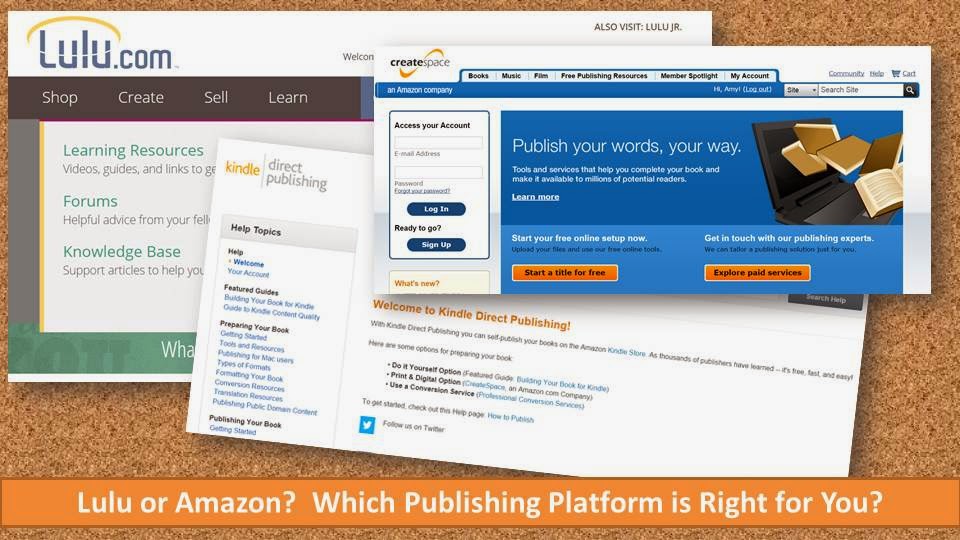 |
| Customers and Costs are Two Major Considerations |
Are you considering publishing using either Amazon or Lulu? There are benefits and drawbacks to each.
Although other publishers may hold opposing views, here's the skinny according to Amy Lynn.
The Pros and Cons of Publishing Using Amazon's CreateSpace and Kindle Direct Publishing
The Benefits
The three most important reasons why I prefer Amazon to Lulu are all related to Amazon's infallible ability to sell sell sell.First and foremost, Amazon's pièce de résistance is its number of shoppers and the level of trust those shoppers have when placing online orders. I, myself, lose hours on Amazon some nights just by browsing arts and crafts supplies.
Also, for publishers like me, there are some ways to capitalize on those numbers and that trust while at the same time benefiting the reader - a win win! For example, I can set Kindle Countdown deals, free giveaway days, Kindle Matchbook pricing, or Lending Library settings for each of my books, helping me promote and gain reviews. Furthermore, Amazon will also, at times, reduce the price of my print book while I make the same royalty via my CreateSpace agreement and settings.
Furthermore, Amazon's ability to sell sell sell to readers means they do not try to hard sell me on their packaged publishing services. I know there is help available, but their system is easy enough to navigate, and their rules and formatting guidelines are easy enough to follow, that I do not need to purchase those services. Did I mention they do not push their professional services to me every time I access my account?
The Drawbacks
As with all good things, however, come a few bad. The two worst things I have to say about publishing with Amazon are to do with revenue and bookkeeping.Amazon Kindle Direct and CreateSpace do not allow for multiple payees to be set in their payment systems. If two or more people collaborate on a book, only one of those people will receive payment from Amazon. That places the burden of the split on one person, most likely a person who has little to no experience with bookkeeping. Come tax time, that could be a nightmare.
It's also very difficult to project Kindle Unlimited and Kindle Owners Lending Library revenue. Because it is a sliding relative scale and pool from which writers are paid, no one really knows what to expect month to month. Part of good business is being able to project pipeline income, but with this particular system it is nearly impossible.
The Pros and Cons of Publishing Using the Lulu Platform
The Benefits
So, why, you may be asking, did I publish through Lulu if I appreciate Amazon's ability to sell sell sell?I have one answer only: With Lulu, I can set multiple payees per book with adjustable revenue percentages per person.
In the past I have never truly made profit (or even regained the capital) on published poetry chapbooks. Thus, there wasn't any revenue or royalty to send poets. With Lulu, however, I can offer a revenue split with no capital lost to printing costs. The poet can order and sell as many copies as he wants at any price. In the meantime, the book is also available online to order as an eBook or as a hardcopy. Again, it's a win win!
The Drawbacks
Unfortunately, although the multiple payee system is a BIG benefit, it is really the only benefit to using Lulu instead of Amazon.Lulu's Web site is more difficult to navigate than either the Amazon Kindle Direct Publishing Web site or the CreateSpace Web site. Part of the reason it's difficult to navigate is the abundance of ads for their publishing services that are inserted into the publication process fields or as major sections on each page. It's a very hard sell and could confuse self publishers into thinking these are services they must use instead of services they have the option to use.
Even more of a drawback are Lulu's costs per book. Their print books cost more to order than CreateSpace books. For example, to order my own 30-page book from Lulu costs around $11.00. To order my 150-page book from CreateSpace costs $6.00. Both books have full color interior pages. That discrepancy is glossed over in Lulu's sales pitch that writers will "make more" on Lulu. What they do not mention is that the reader also has to pay a lot more, thereby lessening sales.
In the end, I would much prefer to use Amazon's publishing platforms over Lulu's publishing platform. Even though Lulu's platform allows better management of payments to collaborative teams, Amazon offers many more opportunities for sales and lending than Lulu can offer with sales alone.
Learn more about self publishing your poetry!
By the end of the course, students will know how to plan, produce, and distribute a poetry chapbook.
Copyright Amy Lynn Hess. Please contact the author for permission to republish.
.JPG)
.JPG)


Very informative reading. Thanks
ReplyDelete